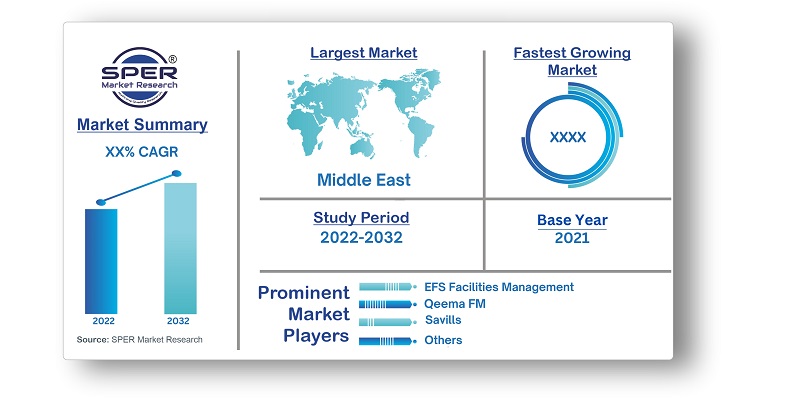
Egypt Facility Management Market Growth, Size, Trends, Demand, Revenue and Future Outlook
Egypt Facility Management Market Size- By Type of Facility Management, By Offering Type, By End User- Regional Outlook, Competitive Strategies and Segment Forecast to 2032
| Published: Feb-2023 | Report ID: IACT2330 | Pages: 1 - 105 | Formats*: |
| Category : Information & Communications Technology | |||

-004281623012024.jpg)
| Report Metric | Details |
| Market size available for years | 2019-2032 |
| Base year considered | 2021 |
| Forecast period | 2022-2032 |
| Segments covered | By Type of Facility Management, By Offering Type, By End-User |
| Regions covered | Alexandria, Delta, Suze Canal, Greater Cairo & Upper North Region, Asyut Region, South Upper Region |
| Companies Covered | Contrack FM, Enova, EFS Facilities Management, IFMC – Apleona Group, Egypro-FME, CBRE, JLL, Qeema FM,G4S, Savills, ProService, Encorp Facility Management, Emdad Facility Management, Egypt Service |
- Inhouse Facility Management
- Outsourced Facility Management
- Single FM
- Bundled FM
- Integrated FM
- Hard FM
- Soft FM
- Commercial
- Institutional
- Public/Infrastructure
- Industrial
- Others
- Alexandria
- Delta
- Suze Canal
- Greater Cairo & Upper North Region
- Asyut Region
- South Upper Region
- Size of Egypt Facility Management Market (FY’2019-FY’2032)
- Overview of Egypt Facility Management Market
- Segmentation of Egypt Facility Management Market By Type of Facility Management (Inhouse Facility Management, Outsourced Facility Management, Single FM, Bundled FM, Integrated FM)
- Segmentation of Egypt Facility Management Market By Offering Type (Hard FM, Soft FM)
- Segmentation of Egypt Facility Management Market By End-User (Commercial, Institutional, Public/Infrastructure, Industrial, Others)
- Statistical Snap of Egypt Facility Management Market
- Growth Analysis of Egypt Facility Management Market
- Problems and Challenges in Egypt Facility Management Market
- Competitive Landscape in the Egypt Facility Management Market
- Impact of COVID-19 and Demonetization on Egypt Facility Management Market
- Details on Recent Investment in Egypt Facility Management Market
- Competitive Analysis of Egypt Facility Management Market
- Major Players in the Egypt Facility Management Market
- SWOT Analysis of Egypt Facility Management Market
- Egypt Facility Management Market Future Outlook and Projections (FY’2019-FY’2032)
- Recommendations from Analyst
1.1. Scope of the report1.2. Market segment analysis
2.1 Research data source
2.1.1 Secondary data2.1.2 Primary data2.1.3 SPER’s internal database2.1.4 Premium insight from KOL’s
2.2 Market size estimation
2.2.1 Top-down and Bottom-up approach
2.3 Data triangulation
4.1. Driver, Restraint, Opportunity and Challenges analysis
4.1.1 Drivers4.1.2 Restraints4.1.3 Opportunities4.1.4 Challenges
4.2. COVID-19 Impacts of the Egypt Facility Management Market
5.1. SWOT analysis
5.1.1 Strengths5.1.2 Weaknesses5.1.3 Opportunities5.1.4 Threats
5.2. PESTEL analysis
5.2.1 Political landscape5.2.2 Economic landscape5.2.3 Social landscape5.2.4 Technological landscape5.2.5 Environmental landscape5.2.6 Legal landscape
5.3. PORTER’S five forces analysis
5.3.1 Bargaining power of suppliers5.3.2 Bargaining power of Buyers5.3.3 Threat of Substitute5.3.4 Threat of new entrant5.3.5 Competitive rivalry
5.4. Heat map analysis
6.1 Egypt Facility Management Market Manufacturing Base Distribution, Sales Area, Product Type6.2 Mergers & Acquisitions, Partnerships, Product Launch, and Collaboration in Egypt Facility Management Market
7.1 Inhouse Facility Management7.2 Outsourced Facility Management7.3 Single FM7.4 Bundled FM7.5 Integrated FM
8.1 Hard FM8.2 Soft FM
9.1 Commercial9.2 Institutional9.3 Public/Infrastructure9.4 Industrial9.5 Others
10.1 Egypt Facility Management Market Size and Market Share by Region (2019-2025)10.2 Egypt Facility Management Market Size and Market Share by Region (2026-2032)10.3 Alexandria10.4 Delta10.5 Suze Canal10.6 Greater Cairo & Upper North Region10.7 Asyut Region10.8 South Upper Region
11.1 CBRE
11.1.1 Company details11.1.2 Financial outlook11.1.3 Product summary11.1.4 Recent developments
11.2 Contrack FM
11.2.1 Company details11.2.2 Financial outlook11.2.3 Product summary11.2.4 Recent developments
11.3 EFS Facilities Management
11.3.1 Company details11.3.2 Financial outlook11.3.3 Product summary11.3.4 Recent developments
11.4 Egypro-FME
11.4.1 Company details11.4.2 Financial outlook11.4.3 Product summary11.4.4 Recent developments
11.5 Egypt Service
11.5.1 Company details11.5.2 Financial outlook11.5.3 Product summary11.5.4 Recent developments
11.6 Emdad Facility Management
11.6.1 Company details11.6.2 Financial outlook11.6.3 Product summary11.6.4 Recent developments
11.7 Encorp Facility Management
11.7.1 Company details11.7.2 Financial outlook11.7.3 Product summary11.7.4 Recent developments
11.8 Enova
11.8.1 Company details11.8.2 Financial outlook11.8.3 Product summary11.8.4 Recent developments
11.9 G4S
11.9.1 Company details11.9.2 Financial outlook11.9.3 Product summary11.9.4 Recent developments
11.10 IFMC-Apleona Group
11.10.1 Company details11.10.2 Financial outlook11.10.3 Product summary11.10.4 Recent developments
11.11 JLL
11.11.1 Company Details11.11.2 Financial outlook11.11.3 Product summary11.11.4 Rcent Developments
11.12 ProService
11.12.1 Company details11.12.2 Financial outlook11.12.3 Product summary11.12.4 Recent developments
11.13 Qeema FM
11.13.1 Company details11.13.2 Financial outlook11.13.3 Product summary11.13.4 Recent developments
11.14 Savills
11.14.1 Company details11.14.2 Financial outlook11.14.3 Product summary11.14.4 Recent developments
SPER Market Research’s methodology uses great emphasis on primary research to ensure that the market intelligence insights are up to date, reliable and accurate. Primary interviews are done with players involved in each phase of a supply chain to analyze the market forecasting. The secondary research method is used to help you fully understand how the future markets and the spending patterns look likes.
The report is based on in-depth qualitative and quantitative analysis of the Product Market. The quantitative analysis involves the application of various projection and sampling techniques. The qualitative analysis involves primary interviews, surveys, and vendor briefings. The data gathered as a result of these processes are validated through experts opinion. Our research methodology entails an ideal mixture of primary and secondary initiatives.



Frequently Asked Questions About This Report
PLACE AN ORDER
Year End Discount
Sample Report
Pre-Purchase Inquiry
NEED CUSTOMIZATION?
Request CustomizationCALL OR EMAIL US
100% Secure Payment






Related Reports
Our Global Clients
Our data-driven insights have influenced the strategy of 200+ reputed companies across the globe.




















